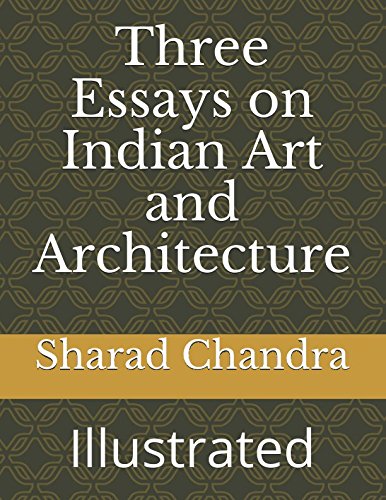Artículos relacionados a Three Essays on Indian Art and Architecture: Illustrated

Reseña del editor:
The art and architecture of India is rooted in its history, culture, and religion. The first two essays in the present volume bring to the fore the folk art of Kalamkari, and the architectural wonder of the stepwells—both part of the ancient heritage, and the third piece dwells on the spectacular art and peculiar habits of the most discussed and most popular contemporary Indian painter, Maqbool Fida Hussain. The first two essays have earlier been published in an online journal, Chitrolekha. Due acknowledgement has been noted at the end of each essay and they are included here with due permission of the editors. I have added a glossary to help readers understand the names of typical Indian ingredients used in the preparation of a Kalamkari painting. Kalamkari or Qalamkari is a type of hand-painted or block-printed cotton textile, produced in parts of India. The word is derived from the Persian words ghalam (pen) and kari (craftmanship), meaning drawing with a pen. Only natural dyes are used in Kalamkari and involves seventeen painstaking steps. This intricate art has been practiced by many families in Andhra Pradesh and over the generations has constituted their livelihood. Admired for its excellent craftsmanship the journey of Kalamkari curiously began with trade in Indian spices. Subsequently merchants and traders from around the world used Indian textiles, the majority of which were kalamkari, as a currency in the Spice Trade. With the passage of time Indian textiles began to be seen as luxury items in themselves, and a variety of textiles and textile-related products found an appreciative market throughout Europe, the Middle East, and Asia. Step wells are wells or ponds in which the water is reached by descending a set of steps. Rock-cut stepwells in India date from 200–400 AD. Gradually they began to be constructed. Step wells developed mainly to cope with seasonal fluctuations in water availability. Deep trenches were dug into the earth for dependable, year-round groundwater, their walls were lined with blocks of stone without mortar, and stairs were built leading down to the water. The construction of stepwells was primarily utilitarian but owing to the significant architectural embellishments on their walls they have today acquired the status of interesting monuments. In olden times stepwells also served as leisure spots, place for social gatherings and religious ceremonies where women prayed and offered gifts to the goddess of the well for her blessings. The last essay describes the spectacular art and mildly eccentric habits of the Indian painter, Maqbool Fida Hussain. With his free-flowing, silvery white beard and hair, dressed in impeccably tailored, expensive Hermes suit, an oversized paintbrush ‘baton’ in hand, walking barefoot M.F. Husain cut a most distinctive figure full of energy and humour. His striking ascetic looks, simple, soft-spoken manner commanded immediate attention and respect. He had a penchant for philosophy, was deeply knowledgeable of, and loved art in all its forms and had several writers and poets as his friends. He always remained in the headlines as much because of his peculiar habits as for his unique art. Hussain stopped wearing footwear in 1974 after walking in the funeral procession of his friend, Gajanan Madhav Muktibodh, the well known Hindi poet and maintained it till the very end.
"Sobre este título" puede pertenecer a otra edición de este libro.
- EditorialIndependently published
- Año de publicación2016
- ISBN 10 1520689527
- ISBN 13 9781520689524
- EncuadernaciónTapa blanda
- Número de páginas51
Comprar nuevo
Ver este artículo
EUR 13,16
Gastos de envío:
EUR 11,63
De Reino Unido a Estados Unidos de America
Los mejores resultados en AbeBooks
Three Essays on Indian Art and Architecture: Illustrated
Publicado por
Independently published
(2016)
ISBN 10: 1520689527
ISBN 13: 9781520689524
Nuevo
Paperback
Cantidad disponible: 1
Librería:
Valoración
Descripción Paperback. Condición: Brand New. 51 pages. 11.00x8.50x0.12 inches. In Stock. Nº de ref. del artículo: zk1520689527
Comprar nuevo
EUR 13,16
Convertir moneda
Gastos de envío:
EUR 11,63
De Reino Unido a Estados Unidos de America
Destinos, gastos y plazos de envío

